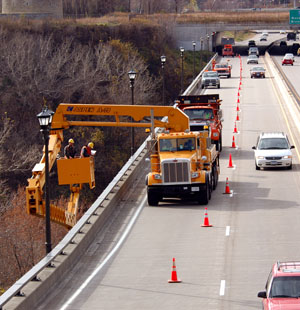 |
|

|
 |
TABLE of CONTENTS
 |
Camp gives kids inside look at Mn/DOT |

About 60 kids attended the Camp Mn/DOT event July 21 at the District 3 office in Baxter. Activities included an outdoor obstacle course, transportation trivia, traffic computer games, office tours, tree planting and prize giveaways.
From Left, Larry Huseth, District 3 Materials, and Scott Ziedler, District 3 Plan Development, play an educational rock and materials game with kids during the materials lab portion of Camp Mn/DOT.
To view more photos of the event, visit ihub/d3/2010campmndot/. Photo by Jenny Seelen
|
|
 |
|

|
 |
TABLE of CONTENTS
 |
New legislation focuses on bridge safety, integrity |
By Erik Rudeen, Government Affairs

A Mn/DOT bridge crew inspects the Hwy 5 bridge over the Mississippi River between St. Paul and Fort Snelling. Recently passed legislation requires Mn/DOT to submit a report to the legislature every other year regarding quality assurance for bridge inspections. Photo by David Gonzalez |
During the 2010 legislative session, numerous laws were enacted to help ensure the safety and integrity of Minnesota’s bridges, including three key pieces of legislation that will directly affect Mn/DOT.
The first key bill directs Mn/DOT to use a portion of research funds on technology related to bridge monitoring and inspection, as well as bridge design and maintenance. The bill includes several reporting requirements on operational changes recommended by various investigations of the department conducted after the collapse of the Interstate 35W bridge in Minneapolis.
Part of the new legislation requires the department to submit a report to the Legislature every other year regarding quality assurance for bridge inspections. The report must include information about:
- Bridge inspection procedures used in Minnesota
- Changes made in response to previous reviews
- Compliance with federal bridge inspection standards
The bill also requires Mn/DOT to issue a report to the Legislature by Feb. 1, 2011 regarding changes in the department’s organization, procedures and processes on bridge issues. In addition, the report must include information on the adequacy of funding for highway and bridge construction and maintenance.
The second piece of legislation, which began as a Mn/DOT initiative, establishes a prioritization system for state highway bridges starting in 2018—after the completion of the Chapter 152 bridge program.
This law expands the current planning process to include risk-based criteria for scheduling bridge repairs and replacements. A risk-based system for bridge project identification will consider both the probability and impact of an interruption in service.
The risk-based system will produce a ranked list of state highway bridges and will be one part of the planning process. Experts from the Bridge Office and districts will apply their knowledge of the bridge inventory to modify the list, with the final outcome being a list of bridge projects for programming.
A third major piece of legislation related to bridges requires Chapter 152 bridge projects to include bike and pedestrian facilities under certain circumstances. The bill also requires bike and pedestrian facilities on bridges to comply with the Americans with Disabilities Act and directs the department to report on how state highway bridges comply with the ADA standards.
For a summary of the 2010 legislative session, visit http://ihub.dot.state.mn.us/governmentaffairs/legislative2010/finalsummary/2010yearend.pdf.
This is the fourth installment in a short series of 2010 Legislative Session highlights.
Previous highlights:
|
 |
|

|
 |
TABLE of CONTENTS
 |
Commissioner's next book discussion set for Aug. 4 |

Julie Skallman, State Aid Division director, will lead the next Commissioner’s Reading Corner book discussion Aug. 4. Photo by Qin Tang |
Employees interested in attending the fifth installation of the Commissioner’s Reading Corner discussion can still sign up at ihub/readingcorner/index.html. Julie Skallman, State Aid Division director, will lead a discussion of “That’s Not What I Meant!: How Conversational Style Makes or Breaks Relationships,” by Deborah Tannen.
The discussion will take place Wednesday, Aug. 4, at 1:30 p.m., in Central Office Conference Room 461. Employees can also participate virtually via Adobe Connect and should log in as a guest no earlier than 1:15 p.m. All employees are encouraged to attend, even if they have not yet read the book, according to Qin Tang, Mn/DOT librarian.
Employees can also prepare for future book discussions by checking out other titles on the reading corner book list, which includes “The World's Most Powerful Leadership Principle: How to Become a Servant Leader,” by James C. Hunter. Mike Barnes, Engineering Services Division director, will lead a discussion of that book Sept. 1.
Other upcoming discussions will include these titles, which are available in the Commissioner's Reading Corner at the Mn/DOT Library:
- A New Breed of Leader: 8 Leadership Qualities that Matter Most in the Real World: What Works, What Doesn't, and Why
- How Successful People Think: Change Your Thinking, Change Your Life
- The Trusted Leader: Building the Relationships that Make Government Work
- The 21 Irrefutable Laws of Leadership: Follow Them and People Will Follow You
- Collaborative Leadership: How Citizens and Civic Leaders Can Make a Difference
- Jeffrey Gitomer's Little Teal Book of Trust: How to Earn It, Grow It, and Keep It to Become a Trusted Advisor in Sales, Business & Life
- Nuts! Southwest Airlines' Crazy Recipe for Business and Personal Success
Employees with questions can contact Rebecca Fabunmi, special assistant to the commissioner, at 651-366-4808. To read an interview featuring Skallman’s reaction to the latest book, visit ihub.dot.state.mn.us/readingcorner/interviews.html. |
 |
|

|
 |
TABLE of CONTENTS
 |
E-mail subscription service helps customers stay connected |
By Kay Korsgaard
Nearly 10,500 people are now signed up to receive e-mail updates from Mn/DOT on various topics including construction projects and how the department is planning for future projects.
Since the department started offering the service in 2007, more than 1.2 million e-mails have been sent to subscribers.
How does it work?
From Mn/DOT’s Web site, customers can access a central signup page where they can select from about 40 lists currently offered. From that same page, customers also can update their e-mail address or subscribe to new lists.
The e-mails supplement other communication tools, such as news releases and the department’s Web site, but have the advantage of letting Mn/DOT put information directly in the inboxes of interested customers.
The service also allows the department to track the effectiveness of e-mail communications. For example, nearly 41 percent of Mn/DOT e-mails are opened compared to an industry average of 23 percent for other government communications.
Nobody relishes getting stuck in traffic, but e-mail alerts are helping to take the sting out of some traffic delays and detours.
“I experienced driving this section of I-494 during phase 1 of the road construction last summer and not knowing when exits and entrances would be open made commuting very long and stressful,” one customer recently wrote. “Using the e-mail updates you send, I have been able to work around them.”
For more information about the service and how it can help you communicate about various projects, contact Kay Korsgaard, Communications, at 651-366-4267. |
 |
|

|
|

|
 |
TABLE of CONTENTS
 |
Statewide Freight and Passenger Rail Plan receives national award |

Mn/DOT recently received a national Transportation Planning Excellence Award for its 2009 Minnesota Comprehensive Statewide Freight and Passenger Rail Plan. Photo by David Gonzalez
|
The 2009 Minnesota Comprehensive Statewide Freight and Passenger Rail Plan, a strategic vision for enhancing the movement of people and freight and improving access to goods and services, recently received a national Transportation Planning Excellence Award.
The award was presented July 11 by the Federal Highway Administration, the Federal Transit Administration and the American Planning Association at the Transportation Research Board meeting in Minneapolis.
“In developing this comprehensive state rail plan, we have created a map for commodity movement by rail as well as a passenger rail network of linked routes that will improve travel times, energy conservation, environmental impacts, and traveler convenience throughout the region,” said Tom Sorel, Mn/DOT commissioner.
Mn/DOT was one of 11 winners of the biennial award, which recognizes outstanding initiatives nationwide that develop, plan and implement innovative transportation planning practices. Ninety projects competed for the award.
The panel of judges noted the plan’s comprehensive and balanced nature, data-driven approach, vision for the future, and leadership and compliance in responding to emerging federal requirements and guidelines.
In addition, the plan was the only effort judged to have demonstrated outstanding contributions in three separate categories—Freight Planning, Planning Leadership, and Public Involvement and Outreach, according to Dave Christianson, project manager.
Using data and planning analysis from the state rail plan, Mn/DOT and its partners submitted grant applications for rail-related projects to the federal Transportation Investment Generating Economic Recovery program. As a result, the state received funding for the completion of the St. Paul Union Depot. Minnesota also was awarded the only basic high-speed planning grant in the country from first round stimulus funding for development of the Chicago-Twin Cities corridor.
“We’re already seeing pay-offs from this comprehensive plan, and look forward to future achievements in the areas of freight and passenger rail for our state and the region,” Sorel said. “Mn/DOT shares this award with our partners and the transportation stakeholders who participated in this landmark planning effort.”
To view the 2009 Minnesota Comprehensive Statewide Freight and Passenger Rail Plan, visit Mn/DOT’s Web site at http://www.dot.state.mn.us/planning/railplan/.
For information about the Transportation Planning Excellence Award, see https://www.fhwa.dot.gov/planning/tpea/2010/. |
 |
|

|
 |
TABLE of CONTENTS
 |
District 3 takes steps to prevent on-the-job injuries |
By Angela Mathis

From left, Mike Badger, District 3 Inventory; Rod Mrozek and Larry Gilbertson, District 3 Repair Shop, perform their morning stretches before heading back to work. The exercises are part of the Mn/STEP program, which was named by Tim Paul, District 3 Surveys. Photo by Jenny Seelen |
District 3 recently “stepped up” with a flexibility program that aims to reduce injuries at work by requiring employees to stretch daily.
Since late February, District 3 Maintenance employees have been following the aptly named “Stretching Together Employee Program” by participating in morning stretching exercises as a group and afternoon exercises individually.
“Our hope is to prevent overexertion strain and sprain injuries, which are among the most common injuries occurring in our district,” said Lisa Dumont, District 3 Workers’ Compensation and Injury Management coordinator.
Research shows that companies with flexibility programs have seen reductions in soft-tissue injuries and severe injuries, lower medical costs and a decrease in lost time, according to Dumont.
“I am confident that Mn/DOT will benefit from our flexibility program as well,” Dumont said.
A committee of labor and management volunteers developed the program by reviewing a variety of stretches designed by a physical therapist and then selecting 12 simple-but-effective stretches, according to Dumont.
“I am pleased that our District Management Team, Safety Committee and the Labor/Management Committee have taken the initiative to support a program that is the first of its kind at Mn/DOT,” Dumont said. “I am proud to work for an organization that has such a strong commitment to employee health and safety.”
Besides instructing employees on how to stretch, Mn/STEP training involves talking about why stretching is important for preventing injuries and staying healthy. These discussions have sparked positive feedback, according to Dumont.
“Employees like to hear that we’re thinking about them and their best interests,” Dumont said. “It’s really a win-win for everyone.”
Last year at this time, District 3 had 21 injuries that had to be recorded based on Occupational and Safety Health Administration criteria, according to Dumont. So far this year, there have been eight.
“Since a lot of variables, such as training, employee responsibility and corrective action, go into safety, we can’t attribute the decrease in OSHA recordable injuries solely to Mn/STEP,” Dumont said. “But the program is definitely part of the puzzle and a step in the right direction.”
Earlier this month, Dumont spoke with District 3 office workers about the program—in particular, about ergonomics and flexibility. They now stretch at various times throughout the day.
Other districts have been inquiring about the program as well, including Metro District, which adopted some of the stretching routines for Maintenance staff, according to Dumont.
To view the Mn/STEP stretching routines, visit http://ihub/d3/. For more information about the program, contact Lisa Dumont at 320-223-6592. |
 |
|

|
 |
TABLE of CONTENTS
 |
Road Closed: Research project analyzes full-closure construction |
|
By Bob Filipczak In the back of your mind, you probably knew that completely closing a road during construction makes sense in terms of efficiency and safety. But could you prove it?
Mn/DOT and University of Minnesota research staff can. In fact, the recent Research Services report, “TH-36 Full Closure Construction: Evaluation of Traffic Operations Alternatives,” analyzed how closing a highway affects the project and the public.
In 2007, the department closed Hwy 36 in North St. Paul, which at the time was the largest full closure the department had ever planned and executed. This gave researchers an opportunity to evaluate the actual impact of a full closure in real time and measure how it affected nearby highways, local roads and safety.
Highways
The congestion impact from the full closure was mild, but it extended over a large area. Because many commuters from Wisconsin use Hwy 36, when it closed, some chose to cross the St. Croix River at Interstate 94 rather than Stillwater.
Local Roads
Two of the 12 local roads measured experienced some congestion—most local roads had enough spare capacity.
Safety
The Minnesota State Patrol and local police were originally on call for a week, but after two days it was determined that their services were not needed.
Overall, the team concluded that the construction cost savings far outweighed the increase in Road User Costs, which is a calculation designed to measure how much impact construction has on motorists. The research team also did a before-and-after snapshot of public perception. Before the full closure, there was a 50-50 split in public opinion whether it was a good idea. After the project was complete:
- 92 percent of residents agreed that a full closure was the right plan of action.
- 84 percent of businesses agreed with the decision to fully close the highway.
- 87 percent of commuters supported a full closure.
“There were a lot of early discussions about using full closure, and we thought people would be very uncomfortable with that. But our market research told us we could turn that around if we did it right,” said Commissioner Tom Sorel in an interview with the Federal Highway Administration’s Innovator newsletter.
To view the entire Hwy 36 full-closure report, visit http://www.lrrb.org/pdf/201004.pdf. To view a two-page wrap up of the report, visit http://www.lrrb.org/pdf/201004TS.pdf.
Transportation Research Board Annual Visit set for Aug. 9
The Transportation Research Board will have their Annual Visit Aug. 9. All employees are welcome to attend the TRB program presentation and brown bag lunch at noon and the TRB Web site overview at 1 p.m. Both presentations will be held in Central Office Conference Room G22.
The closed portion of the meeting will feature a round-table discussion with Division directors. Christine Gerencher, TRB representative, will then meet with specialty offices throughout the day to share information and learn about current research activities being performed within those offices.
To view the agenda, visit http://www.dot.state.mn.us/research/documents/TRB Agenda 2010.doc.
|
|
 |
|
| |
|



